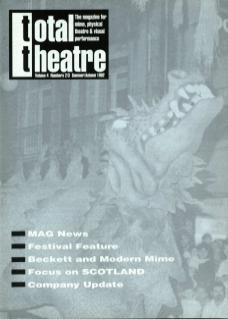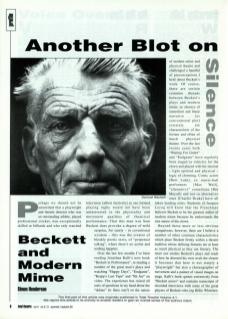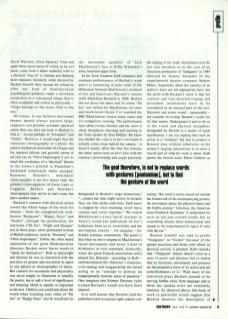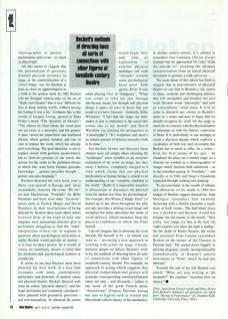It is well known that Beckett (and his publisher) tried to exercise tight control over the staging of his work. Sometimes even the law was invoked, as in the case of an American production of Endgame in 1984 directed by Joanne Akalaitis of the experimental theatre company Mabou Mines. Arguments about the sanctity of an author's texts are not appropriate here, but the point with Beckett's work is that his copious and very detailed staging and movement instructions have to be considered as an integral part of the text. Directors and actors would – presumably – not consider rewriting Beckett's words (or for that matter Shakespeare's) and to do so to the visual and physical metaphors designated by Beckett is a matter of equal significance. I am not arguing that such an action is a ‘violation’ but that to produce a Beckett play without adherence to the author's staging instructions is to miss a crucial part of what his work is about. Kalb quotes the French actor, Pierre Chabert, as saying: ‘the word is never conceived outside the framework of the accompanying gesture, the movement, place, the physical stance and the bodily posture.’ Likewise, the American actor Frederick Neumann: ‘I understand his texts as not just written words, but as something almost three-dimensional and meant to be experienced in space if only with the ear.’
Beckett himself was said to prefer Endgame to Godot because of the greater precision and detail with which its physical activity is planned. Kalb remarks that ‘Endgame almost doesn't exist as a story if actors and directors fail to realise that its histrionic movements and gestures are the propulsive force of its action and not embellishments of it’. With many of his television plays Beckett seemed to be moving further away from language and in these the spoken texts are extremely minimal. As observed above, this body of work in particular would suggest that Beckett deserves the description of choreographer or painter – performance artist even – as much as playwright.
All this seems to suggest that the presentation of precisely denoted physical action[s] on stage, or the communication of a visual image, was for Beckett at least as close an approximation to a truth as the spoken word. In 1982 Beckett told his Stuttgart camera-man on the set of Night and Dreams that it was ‘difficult for him to keep writing words, without having the feeling it was a lie’. Compare this to the words of Jacques Lecoq, quoted in Mira Felner's book The Apostles of Silence: ‘The silence de fond where the word does not yet exist, is a necessity, and the gesture is pure versus the superficial and mutilated silence, where gesture imitates, and tries in vain to replace the word, which has already said everything. The goal therefore, is not to replace words with gestures (pantomime), but to find the gesture of the word, the actions for the verbs in the profound silence in which they were born. Gesture precedes knowledge... gesture precedes thought... gesture precedes language.’
Beckett directed his own work over a thirty-year period in Europe and, more occasionally, America. He wrote Eh Joe for Jack MacGowran, Footfalls for Billie Whitelaw and there were other ‘favourite’ actors such as Patrick Magee and David Warrilow. In their recollections of being directed by Beckett these and other actors received little of the kind of help one imagines most mainstream directors give to performers struggling to find the ‘right’ interpretation of their role. In response to questions about psychological motivation or reality Beckett would provide no answer – or at least no direct answer, for it would, of course, be manifestly absurd to claim that his characters lack psychological richness or complexity.
It seems to me that Beckett must have directed his own work in a way that resonates with many contemporary performers and directors of modern mime and physical theatre. Beckett directed with what he called ‘physical themes’, and his stage movement was extremely calculated – often planned with geometric precision – and non-naturalistic. In rehearsal his actors would begin their task with an exploration of external physical technique and work ‘inwards’ towards some psychological focal point. Kalb quotes Peter Evans when playing Clov in Endgame: ‘When you create [a role] not just through intellectual means but through real physical things it opens all sorts of doors that you could never have foreseen.’ Similarly, Billie Whitelaw: ‘I feel that the shape my body makes is just as important as the sound that comes out of my mouth.’ And David Warrilow (on playing the protagonist in Catastrophe): ‘It's sculptural and there's an infinite amount of delicate muscular work to be done.’
For Beckett (writer and director) these choices were not simply about choosing the ‘technique’ most suitable to an accurate realisation of his work on stage, but they were, I believe, completely integral to a view which claims that our physical predicament as human beings is central to an understanding of our ‘complete condition in the world’ (Kalb). It is impossible therefore to disassociate or disconnect the physical from the spoken text from the psychological. For example, that Winnie (Happy Days) is buried up to her chest throughout the play not only provides a striking visual image and metaphor but helps determine the mode of vocal delivery which emanates from the physical conditions in which she finds herself.
I do not imagine that in directing his work Beckett felt himself to be – or indeed was seen as – inventing a new approach to working with actors on stage. Clearly, however unique we believe Beckett's work to be, his methods of directing have all sorts of connections with other figures of twentieth-century theatre. For example, an approach to acting which suggests that physical comportment and gesture will generate corresponding emotional/mental states not only – and obviously – relates to the work of the great French mime ‘theoreticians’ (Copeau, Decroux, Lecoq) but also to figures such as Artaud and Meyerhold with his theory of biomechanics.
In another context entirely, it is salutary to remember that Laurence Olivier always claimed that he approached his roles ‘from the outside in’, reaching the ultimate characterisation from an initial physical movement or gesture, a walk and so on.
The main thrust of this article has been to suggest that as practitioners of physical theatre we can find in Beckett a rich source of ideas, material and challenging practice that will strengthen and broaden our own work. Beckett wrote ‘physically’ and with an extraordinary visual sense. It is in no sense to diminish any claims on Beckett's status as a writer and poet to argue that we should recognise his work for the stage as much for its concern with the physicalisation of meanings as with the literary expression of them. It is particularly in our attempts to create a physical theatre which explores a vocabulary of both text and movement that Beckett has so much to offer. As a writer – from the first stroke of his pen – he visualised his plays on a mental stage: as a director he worked as a choreographer of images which function both subliminally – as in the relentless pacing in Footfalls – and directly, as in Didi and Gogo's friendship expressed through walking and jumping.
To end anecdotally: in the wealth of tributes and obituaries on his death in 1989 two images of Beckett suggest themselves. John Montague remembers him earnestly discussing with a Dublin journalist a rugby team of Irish writers. The half-blind Joyce was a problem and Beckett would not relegate his old master to the bench: ‘Very crafty, very nippy, try him at fly half. He might surprise you when the light is fading.’ On the death of Buster Keaton, the writer and journalist Peter Lennon remembers Beckett on the terrace of the Closerie (a Parisian bar): ‘He settled down happily to drawing diagrams, totally incomprehensible journalistically, of Keaton's precise movements in Film which he had just directed.’
Towards the end of his life Beckett was asked: ‘What are you writing at the moment?’ He replied: ‘Another blot on silence.’
Apart from Lecoq's words and those drawn from Beckett's obituaries all quotations are taken from Beckett in Performance by Jonathan Kalb (Cambridge University Press, 1991).



